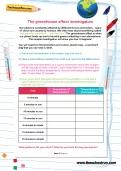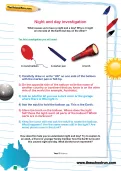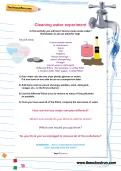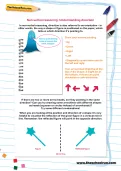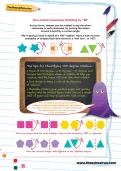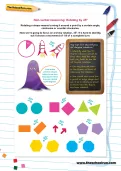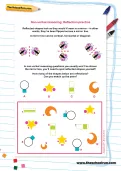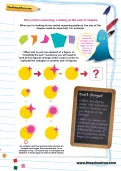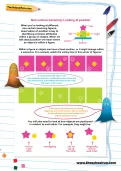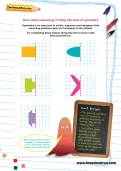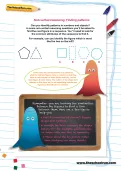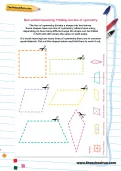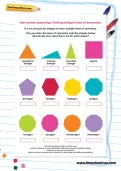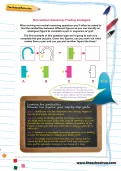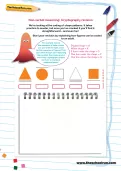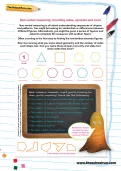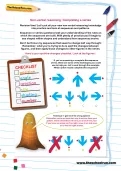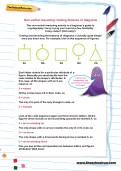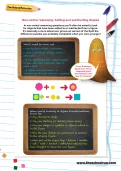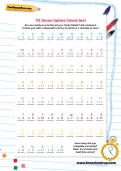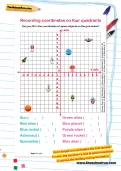In non-verbal reasoning, direction is also referred to as orientation – in other words, the way a shape or figure is positioned on the paper, which tells us which direction it’s pointing to. Have a go at these practical non-verbal puzzles and remember to think about the direction each shape is pointing in. Find the odd one in the group of figures.
or
Register to add to your saved resources
Already a subscriber? to view this content.
Shapes can be rotated in any direction, clockwise or anti-clockwise, by turning the shape around a point by a certain angle. We’re going to look in detail at a 180° rotation. How would the figure on the left look when rotated by 180º clockwise?
or
Register to add to your saved resources
Already a subscriber? to view this content.
Rotating a shape means turning it around a point by a certain angle, clockwise or counter-clockwise. Now we’re going to focus on a tricky rotation, 45º. It’s hard to identify, but it shows a movement of 1/8 of a complete turn. How would the figure on the left look when rotated by 45º clockwise?
or
Register to add to your saved resources
Already a subscriber? to view this content.
Reflected shapes look as they would if seen in a mirror – in other words, they’ve been flipped across a mirror line. In non-verbal reasoning questions you usually won’t be shown the mirror line, you’ll need to spot reflected shapes yourself! Can you find the reflection of the shape on the left?
or
Register to add to your saved resources
Already a subscriber? to view this content.
When you’re looking at non-verbal reasoning patterns, the size of the shapes could be important. Can you solve these analogy questions?
or
Register to add to your saved resources
Already a subscriber? to view this content.
When you’re looking at different non-verbal reasoning figures, observation of position is key to identifying common attributes within a group of shapes. When we talk about position we mean where an object is within a figure. Are you ready to check your understanding of position in some non-verbal reasoning figures? Which figure belongs to the group?
or
Register to add to your saved resources
Already a subscriber? to view this content.
11+ non-verbal reasoning worksheet created by an 11+ expert. Includes non-verbal reasoning examples and answers.
or
Register to add to your saved resources
Being able to identify rotated shapes takes lots of practice! Which of these shapes can be formed by shrinking the shape on the left and rotating it?
or
Register to add to your saved resources
Already a subscriber? to view this content.
Symmetry is so important to artists, engineers and designers that reasoning questions give a lot emphasis to the subject. Can you work out which of these figures has TWO lines of symmetry?
or
Register to add to your saved resources
Already a subscriber? to view this content.
Can you identify patterns in numbers and objects? In some non-verbal reasoning questions you’ll be asked to find the next figure in a sequence. You’ll need to look for the common attributes of the sequence to find it. Find one figure from the group on the right that belongs to the group on the left.
or
Register to add to your saved resources
Already a subscriber? to view this content.
Sometimes a non-verbal reasoning question will ask you to focus on shapes with a specific number of lines of symmetry. Which of these figures has only ONE line of symmetry?
or
Register to add to your saved resources
Already a subscriber? to view this content.
It’s not unusual for shapes to have multiple lines of symmetry. Can you draw the lines of symmetry onto the shapes below and decide how many there are for each shape? Then work out which of the figures has MORE THAN TWO lines of symmetry.
or
Register to add to your saved resources
Already a subscriber? to view this content.
When solving non-verbal reasoning questions you’ll often be asked to find the similarities between different figures so you can identify an analogous figure to complete a pair or sequence or grid. Can you solve this ‘complete the pair’ puzzle by choosing the correct option?
or
Register to add to your saved resources
Already a subscriber? to view this content.
Are you ready to decode some codes? Work out the code for the fifth shape.
or
Register to add to your saved resources
Already a subscriber? to view this content.
Non-verbal reasoning is all about understanding sequences of shapes and patterns. You might be looking for similarities or differences between different figures. Alternatively, you might be given a series of figures and asked to complete the sequence with another figure. In this series of exercises, the first two shapes are related by a specific feature they have in common. Choose the one figure from the five choices that is most like the two figures on the left.
or
Register to add to your saved resources
Already a subscriber? to view this content.
Sequence or series questions test your understanding of the rules on which the sequences are built. With plenty of practice you’ll begin to see shapes within shapes and understand how sequences evolve. Find the figure that comes next in these sequences.
or
Register to add to your saved resources
Already a subscriber? to view this content.
This non-verbal reasoning activity is a beginner’s guide to cryptography. Fancy trying your hand at a few fiendishly tricky codes? Let’s put your code-breaking skills into practice!
or
Register to add to your saved resources
Already a subscriber? to view this content.
In non-verbal reasoning questions you’ll often be asked to look for objects that have been added to or subtracted from a figure. It’s basically a more advanced, grown-up version of the Spot the
difference puzzles you probably completed when you were younger! Apply your figure-adding and -subtracting skills to these practical exercises.
or
Register to add to your saved resources
Already a subscriber? to view this content.
Are you ready to practise all your times tables? Ask someone to time you with a stopwatch and try to finish in 4 minutes or less!
or
Register to add to your saved resources
Already a subscriber? to view this content.
Can you fill in the coordinates of space objects on the grid?
or
Register to add to your saved resources
Already a subscriber? to view this content.
